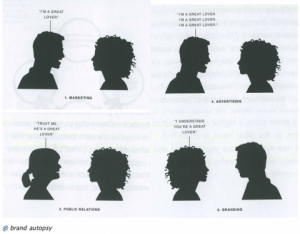 A couple of weeks ago, Steve Cody wrote “You Don’t Know Jack About Public Relations” in his Inc. column.
A couple of weeks ago, Steve Cody wrote “You Don’t Know Jack About Public Relations” in his Inc. column.
I know Steve. He and I both are cyclists and favor shipping our bikes to Counselors Academy every year so we can ride with a small group of friends.
I like him. A lot.
I respect the heck out of him for the agency he’s built in the last 16 years.
But he’s wrong about the difference between advertising and PR. Rather, he’s describing publicity, and that’s what is wrong with the perception of our industry.
We are not just publicists. It’s ONE tactic we use in an overall communication program.
He started off the description of the differences between advertising and PR so well:
I believe far too many chief executives officers of the country’s fastest-growing companies have no real clue how truly multi-faceted and more powerful public relations is than its marketing counterparts.
Totally agree!
But then it went off the rails:
Public relations, which is sometimes referred to as unearned media, is more of a dog’s breakfast. It involves reaching out to an objective reporter, editor, or producer with the facts and figures about an organization, its products or services and hoping the journalist finds the information of interest to her readers, viewers, or listeners. But, and this is a huge but, it is entirely up to the journalist what is written and when it appears.
Let’s put aside the fact he said PR is unearned media (it’s earned media so we’ll assume that’s a typo), what he is describing is publicity – or media relations.
Our industry, for a very long time, has used media relations as the example when describing what we do because it’s tangible. Just like you can hold or view an ad, you can hold or view a story a reporter has written or produced. But it’s doing us a huge disservice.
There are many other tactics we use: Crisis planning, monitoring and listening, issues management, messaging, creating and telling stories, speaking engagements, content development, events, guerilla marketing, internal communication, social media, lobbying, audits, market research, community development, influencer relations, blogger relations, word-of-mouth, contests, trends development, and more.
Some of us even integrate what might be considered more traditional marketing: Email, database development, search engine optimization, trade shows, search engine marketing, inbound marketing, cultivate and convert leads, gamification, and mobile technology.
When you combine tactics such as these, you have an integrated marketing and communication program that drives results. Real results such as improved margins, shortened sales cycles, and increased revenues.
I agree with Steve that when you say you’re in PR, people’s eyes glaze over.
There’s nothing more fun than going to a cocktail party with your charismatic, charming, extroverted husband who is in politics. People want to talk to him.
Me? The best they can come up with is, “What’d you think of the Super Bowl ads?” or “Do you watch Mad Men?”
We’re natural storytellers…so why can’t we describe what we do in an exciting, and more accurate, way?